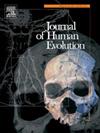南猿上颌骨的形态变异
IF 3.1
1区 地球科学
Q1 ANTHROPOLOGY
引用次数: 0
摘要
关于东非上新世中期人类多样性的讨论的核心是,某些化石是否应该归于南方古猿阿法种,而不是代表单独的物种。回答这个问题的关键是对南方南方古猿种内变异的大小和模式有一个很好的理解。考虑到上颌特征在早期古人类物种诊断中的重要性,我们对哈达尔所有保存完好的9种阿法南方古猿上颌进行了形态学变异研究。在基于ct的虚拟重建之后,这些数据在448个现存的人类(现代人类和非洲猿)上颌骨的比较背景下进行了分析,这些上颌骨代表了所有目前公认的亚种,大地理区域和两性。采用三维地标法捕获上颌形态,并用几何形态计量学方法检测大小和形状。主要发现有:(1)阿法古猿与现存人科动物相比,其大小和形状有较大差异,可能与性别二态性有关;(2)未发现异速生长,但尺寸差异较大;(3)上颌大小有时间变化趋势,但形状没有变化趋势;(4)推测的形状和形状的性别二态性模式与智人、潘人和大猩猩不同。这些结果提供了对南方古猿阿法种更深入的了解,可以与肯尼亚猿人(Kenyanthropus platyops)、deyiremeda南方古猿(Australopithecus deyiremeda)和bahrelghazali南方古猿(Australopithecus bahrelghazali)的当代上颌进行定量比较,并可以帮助评估其他上新世-更新世人科动物的变异,例如那些属于早期人属的物种。本文章由计算机程序翻译,如有差异,请以英文原文为准。
Morphological variation of the Australopithecus afarensis maxilla
Central to discussions about hominin diversity in the mid-Pliocene of eastern Africa is whether or not certain fossils should be attributed to Australopithecus afarensis, instead of representing separate species. Key to answering this question is a good understanding of the magnitude and pattern of intraspecific variation shown by A. afarensis. Given the importance of maxillary characteristics in species diagnoses of early hominins, we explored morphological variation among all nine sufficiently preserved A. afarensis maxillae from Hadar. After CT-based virtual reconstruction, these were analyzed in the comparative context of 448 extant hominine (modern human and African ape) maxillae, representing all currently recognized subspecies, large geographic areas, and both sexes. Maxillary morphology was captured by three-dimensional landmarks, and size and shape were examined using geometric morphometric methods. The main findings are that 1) A. afarensis has high degrees of size and shape variation compared with extant hominines, potentially linked with sexual dimorphism, 2) no allometry was found, despite the large size variation, 3) a temporal trend in maxillary size is suggested but not in shape, and 4) the inferred patterns of sexual dimorphism in form and shape are different from those observed in Homo sapiens, Pan, and Gorilla. These results provide a greater understanding of A. afarensis, enable quantitative comparisons with contemporary maxillae attributed to Kenyanthropus platyops, Australopithecus deyiremeda, and Australopithecus bahrelghazali, and can help evaluate variation in other Plio-Pleistocene hominins, such as those assigned to species of early Homo.
求助全文
通过发布文献求助,成功后即可免费获取论文全文。
去求助
来源期刊

Journal of Human Evolution
生物-进化生物学
CiteScore
6.30
自引率
15.60%
发文量
104
审稿时长
3 months
期刊介绍:
The Journal of Human Evolution concentrates on publishing the highest quality papers covering all aspects of human evolution. The central focus is aimed jointly at paleoanthropological work, covering human and primate fossils, and at comparative studies of living species, including both morphological and molecular evidence. These include descriptions of new discoveries, interpretative analyses of new and previously described material, and assessments of the phylogeny and paleobiology of primate species. Submissions should address issues and questions of broad interest in paleoanthropology.
 求助内容:
求助内容: 应助结果提醒方式:
应助结果提醒方式:


